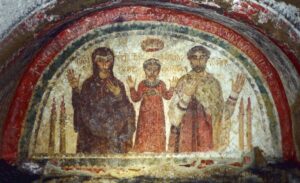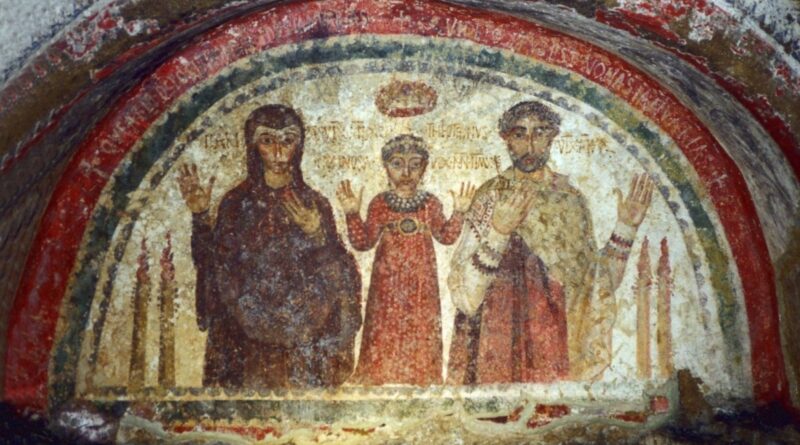Uncommon First Names in Early Italian Records: Exploring Unique Naming Practices of the Past

Contrary to popular belief, not all Italian given names have Christian or classical roots. Many names in older records can be quite whimsical and cannot easily be translated into Latin or another language; so in order to prevent any mistranscription of a given name unfamiliar to you it would be useful if at least some knowledge could be acquired about these names, or at least their onomastic patterns underlying them.
Italians were commonly given names inspired by saints or classical (sometimes mythological ) figures; some of these names could even have been quite uncommon centuries ago. Castrenze, Calcedonio, Baldassare, Cipriano, Zenone and Egidio are religious icons often revered in localities where these saints are honored; Dario, Achille Eusebio Fabio Enea are four classical names to consider as well. Many classical names (Gennaro, Elena, Ascanio and Silvio are examples) which originated from pagan traditions have come to be associated with Christians who were canonized by early Church. Names in this category may also include Damiata, Desciata and Desideria; Centuri (Centaur), Zenone (Xenon), Cruciano Criciana Imperia Pompeo Valenzo Dionisi – among many more! Under Catholic pastoral theology and practice – rather than canon law – Catholic baptismal names must be associated with specific saints. So it is likely that at baptism a “non-religious” given name would have been attached to a Christian name even if this latter does not appear in civil records such as census or vital statistics acts. (It should be noted that, technically speaking, a name needn’t be assigned at baptism; children can still be baptized even without one if desired; however formal nomenclature will help in keeping records.) Some rare names belong to obscure saints who may not be well-known among the public. Many of the more unusual names mentioned here were more frequently heard during the Middle Ages and sixteenth century than more recently; however, recent decades have witnessed an explosion of given names that although seemingly Latin in structure aren’t traditional Italian; for instance: Alba (Dawn), Ambra (Amber), Sabrina, Pamela Melba etc.. Only Sabina and Cinzia Cynthia remain more or less traditional whereas we hear many abbreviated forms like Ivanna from Giovanna) or Giovanni from Giovanni among countless others!
From the Middle Ages through modern era, various factors account for the introduction or extinction of certain given names in Italy. A variety of foreign names were brought over by Franks, Normans and Longobards during conquest and eventually Italianized as Arduino, Ruggiero, Grimaldo Teobaldo etc. Before Inquisition took effect Hebrew and Arabic given names were widely known among Italy’s Jewish and Muslim populations – however due to restrictive legislation they became less frequent over time.
At first, Greek names like Ippolito and Sofia were in use after the Schism. Even as Italian Orthodox communities gradually converted to Roman Catholicism, some names that originated in Greece such as Iorio (from Slavonic Yuri), Giorgio or Nicola continued in use long after. For instance, Nicola shares its ancient root with Ukrainian Mikhola so is closer to its Greek original than Italian versions such as Nicol.
As genealogist working with medieval and sixteenth-century records that may not always be legible, it is crucial for genealogists to know that rare given names may occasionally appear. A researcher can infer them from context if part of it can be read; especially if it’s a well-known surname which they recognize. Even recent records can sometimes present problems as translations from Latin to Italian can sometimes be confusing and there may not exist a vital statistics act (in Italy) as a control for comparison (Salvatrix being Latin for Salvatrice/Salvatora/Salvatora/Salvatrice/Salvatora/Salvatrice).
Translation of Latin names can be an extensive topic unto itself, yet it is interesting to note that certain Old Italian names differ from their modern-day replacements in Italy. Luisa, although popular throughout Italy, hails from Spanish origin; Luigia would be its equivalent in Italian. Biaggio or Biagio was sometimes written out as Blasio when recorded earlier.
Italians of previous centuries generally adhered to tradition when giving their children names; firstborn sons would often take after their paternal grandfather, second-borns after matrilineal grandparents, first daughters after paternal grandmothers etc. Yet some parents deviated from this practice by giving their children more nondescript Christian names (Giuseppe, Giovanni, Maria Caterina Anna etc)
American, Canadian and Australian researchers should be mindful of how certain English translations from Italian descendants in these countries have sometimes distorted our perceptions of traditional Latin names. Donald is not an accurate translation of Domenico (Eng. Dominic), while Donna does not refer to an Italian given name but instead serves as an honorific title (Lord and Lady respectively in Italy). Madonna however was once more common devotionally.
Piedmontese and Sicilian, now considered regional dialects, gave rise to certain given names that became less frequent as Tuscan supplanted these languages as the standard written and spoken language in various Italian states and among aristocracy members. Therefore, some regional names may have appeared prominently in 16th-century records but be nearly forgotten by 18th-century records; however during the nineteenth century there was a sudden revival of interest by emerging bourgeoisie for more obscure classical and devotional names that appeared more often than previously thought.
Unfortunately, many rare names found in old records have become lost over time and in most instances records themselves have been lost or destroyed. Because southern records (whether census or parochial acts) of the sixteenth century tend to have survived better than northern or central ones; all examples listed below come from Southern records with particular emphasis placed upon those not often referenced by onomastic references.
Milvia and Milvio, two names with deep historical associations for South Albanian communities as well as Romans. Both names honor ConstantineOs victory at Ponte Milvio Bridge in Rome where Milvian Bridge (Ponte Milvio) stands today.
An interesting medieval practice which survived into the sixteenth century was giving children names of living grandparents with whom they shared basic names as dimintives. These dimunitives served a dual purpose in that they helped distinguish first cousins who otherwise bore identical given names and surnames from each other, yet these dimunitives became widely accepted as individual names. Antonello (or Antonino), from Antonio and Antonella from Antonia. These names remain common today. Older examples include Catrinella from Caterina, Margaretella from Margarita, Giovanello from Giovanni, Lionello from Leone and Giovanella (and sometimes Ianella or Janella) from Giovanna. Antonia also gave rise to two variants; Antonina and Antonietta.
Barbaro, masculine form of Barbara, has become almost obsolete over time; similarly Minzico and Masullo as well as their feminine equivalents Minzica and Masulla are virtually unknown today. Barbriano may derive from Barbaro. Geronimo was an older form of Gerolamo while Cola is actually an abbreviation for Nicola; Toro derives not from its “bullishness” but rather its Salvatore origins while Bastiano stands for Sebastiano while Bastiana stands in place for Sebastiana; Minico/Minichello derives from Domenico while Minica stands for Domenica).
Saints with names that focus on virtues (Providenza, Felicia) may seem common nowadays, but historical records contain many more surprising names like Dea (Goddess), Potenzia (Strength) and Vergine. Also in older records we find Madonna, Santa (Saint), Bellissima and Venera are less frequently encountered among other saintly names – more typical would be: Madonna; Santa (Saint), Bellissima and Venera are equally unheard-of – in addition to Madonna; Santa (Saint) Bellissima. Other saintly names include Venera (Venus as Benefacia; Bonifazia is another name for Bonifazio Boniface) Donisa in addition to Violanti (Violent) as well as obscure ones like Xhumi (Schumi in modern orthography) and Mercurio. Italy features both names Carmela as Camilla as well.
Orestrina, Furella (Sicilian for Fiorella), Fiori (Fiore), Ferenzina, Cumonau and Donisa were rare female names even by 1500; similarly for Valli, Zalli, Galiotto, Manto (probably from Matteo), Vespristiano (likely originally derived from Vespri, “the Sicilian Vespers”) and Angiolino (possibly Angio, which could refer to Anjouan rulers but could also derive from Angelino as dimunitive of Angelino).
Marchisa could come from Marchesa (wife of a Marquis). Tessa may come from Contessa or even Contessa itself. Regina Maria refers to Mary Mother of Christ; Fatta comes from “benfatta” or “benfatto”, meaning well made; Mariella and Mariuccia may be diminutives of Maria; however the latter term can also stand for Marilena which stands for Maria and Elena respectively. Patrizio or Patrick refers to an old rank of untitled nobility while Patricia is known by this term in Italy; in Italian it stands for rank; Patrick stands for untitled nobility status while Patricia would represent an old rank among untitled nobility ranks; while Patrick refers specifically for Italian nobility ranks that existed; therefore both names refers directly.
As many Nordic, Slavic, and Celtic names lack direct Italian translations (Kevin or Svetlana don’t need to be translated), it should be noted that certain non-Latin geographic and personal names have been translated into “New Latin” to facilitate use in Pontifical references.
As with many names readily translated but rare nonetheless, Genoveffa (in Latin: Genovefa) from Genevieve, patroness of Paris is frequently translated but rarely encountered; one such name is Genoveffa from Woden the Norse god who Wednesday is named for. (This may sometimes be found as Jennifer.) A rarer Italian version is Genevra or Ginevra; sometimes Ginevra refers to Geneva, although most often given as translation for Welsh-Saxon Guinevere or Arturo while medieval forms such as Artu or Merlino can also exist for Geneva cities). Genvra most often serves as translation for Welsh-Saxon Guinevere or Arthur who’s medieval form Arturo while Artu medieval form was Artu whereas Merlino would likely appear when dealing with older records whereas Wendy who comes from Woden King of Norse gods’s Wednesday is usually translated Guendolina though unlikely when dealing with older records containing earlier references may appear elsewhere (Wendolina is used).
Some families have an interesting tradition of adopting unappealing or hard to pronounce names; these distinctive legacy names constitute an invaluable heritage asset.
